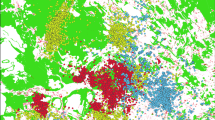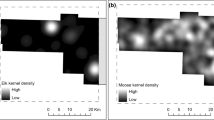Abstract
Grey wolves (Canis lupus), formerly extirpated in Finland, have recolonized a boreal forest environment that has been significantly altered by humans, becoming a patchwork of managed forests and clearcuts crisscrossed by roads, power lines, and railways. Little is known about how the wolves utilize this impacted ecosystem, especially during the pup-rearing summer months. We tracked two wolves instrumented with GPS collars transmitting at 30-min intervals during two summers in eastern Finland, visiting all locations in the field, identifying prey items and classifying movement behaviors. We analyzed preference and avoidance of habitat types, linear elements and habitat edges, and tested the generality of our results against lower resolution summer movements of 23 other collared wolves. Wolves tended to show a strong preference for transitional woodlands (mostly harvested clearcuts) and mixed forests over coniferous forests and to use forest roads and low use linear elements to facilitate movement. The high density of primary roads in one wolf’s territory led to more constrained use of the home territory compared to the wolf with fewer roads, suggesting avoidance of humans; however, there did not appear to be large differences on the hunting success or the success of pup rearing for the two packs. In total, 90 kills were identified, almost entirely moose (Alces alces) and reindeer (Rangifer tarandus sspp.) calves of which a large proportion were killed in transitional woodlands. Generally, wolves displayed a high level of adaptability, successfully exploiting direct and indirect human-derived modifications to the boreal forest environment.




Similar content being viewed by others
References
Bergman E, Garrott R, Creel S, Borkowski J, Jaffe R, Watson F (2006) Assessment of prey vulnerability through analysis of wolf movements and kill sites. Ecol Appl 16:273–284
Bisi J, Kurki S, Svensberg M, Liukkonen T (2007) Human dimensions of wolf (Canis lupus) conflicts in Finland. Eur J Wildl Res 53:304–314
Boitani L (2003) Wolf conservation and recovery. In: Mech LD, Boitani L (eds) Wolves: behaviour, ecology and conservation. University of Chigaco Press, Chicago, pp 317–340
Boyce M, McDonald L (1999) Relating populations to habitats using resource selection functions. Trends Ecol Evol 14:268–272
Büttner G, Feranec J, Jaffrain G, Mari L, Maucha G, Soukup T (2004) The CORINE land cover 2000 project. EARSeL eProc 3:331–346
Ciucci P, Boitani L, Francisci F, Andreoli G (1997) Home range, activity and movements of a wolf pack in central Italy. J Zool 243:803–819
Ciucci P, Masi M, Boitani L (2003) Winter habitat and travel route selection by wolves in the northern Apennines, Italy. Ecography 26:223–235
Edenius L, Bergman M, Ericsson G, Danell K (2002) The role of moose as a disturbance factor in managed boreal forests. Silva Fenn 36:57–67
Eriksen A, Wabakken P, Zimmermann B, Andreassen H, Arnemo J, Gundersen H, Milner J, Liberg O, Linnell J, Pedersen H, Sand H, Solberg E, Storass T (2009) Encounter frequencies between GPS-collared wolves (Canis lupus) and moose (Alces alces) in a Scandinavian wolf territory. Ecol Res 24:547–557
Fortin D, Beyer H, Boyce M, Smith D, Duchesne T, Mao J (2005) Wolves influence elk movements: behavior shapes a trophic cascade in Yellowstone National Park. Ecology 86:1320–1330
Fritts SH (2003) Wolves and humans. In: Mech LD, Boitani L (eds) Wolves: behaviour, ecology and conservation. University of Chigaco Press, Chicago, pp 279–316
Gade-Jørgensen I, Stagegaard R (2000) Diet composition of wolves Canis lupus in east-central Finland. Acta Theriol 45:537–547
Głowaciński Z, Profus P (1997) Potential impact of wolves Canis lupus on prey populations in eastern Poland. Biol Conserv 80:99–106
Hebblewhite M, Merrill E, McDonald T (2005) Spatial decomposition of predation risk using resource selection functions: an example in a wolf–elk predator–prey system. Oikos 111:101–111
Jalanka HH, Roeken BO (1990) The use of medetomine, medetomine–ketamine combinations, and atipamezole in nondomestic mammals: a review. J Zoo Wildl Med 21:259–282
Jędrzejewska B, Jędrzejewski W (1998) Predation in vertebrate communities: the Białowieża primeval forest as a case study. Springer, Berlin
Jędrzejewski W, Schmidt K, Theuerkauf J, Jędrzejewska B, Okarma H (2001) Daily movements and territory use by radio-collared wolves (Canis lupus) in Białowieża Primeval forest in Poland. Can J Zool 79:1993–2004
Jędrzejewski W, Schmidt K, Theuerkauf J, Jędrzejewska B, Selva N, Zub K, Szymura L (2002) Kill rates and predation by wolves on ungulate populations in Białowieża Primeval forest (Poland). Ecology 83:1341–1356
Jędrzejewski W, Niedziałkowska M, Nowak S, Jędrzejewska B (2004) Habitat variables associated with wolf (Canis lupus) distribution and abundance in northern Poland. Divers Distrib 10:225–233
Jędrzejewski W, Jędrzejewska B, Zawadzka B, Borowik T, Nowak S, Mysłajek RW (2008) Habitat suitability model for Polish wolves based on long-term national census. Anim Conserv 11:377–390
Kaartinen S, Kojola I, Colpaert A (2005) Finnish wolves avoid roads and settlements. Ann Zool Fenn 42:523–532
Karlsson J, Brøseth H, Sand H, Andrén H (2007) Predicting occurrence of wolf territories in Scandinavia. J Zool 272:276–283
Kojola I, Aspi J, Hakala A, Heikkinen S, Ilmoni C, Ronkainen S (2006) Dispersal in an expanding wolf population in Finland. J Mamm 87:281–286
Kojola I, Huitu O, Toppinen K, Heikura K, Heikkinen S, Ronkainen S (2004) Predation on European wild forest reindeer (Rangifer tarandus) by wolves (Canis lupus) in Finland. J Zool 263:229–235
Kojola I, Tuomivaara J, Heikkinen S, Heikura K, Kilpeläinen K, Paasivaara A, Ruusila V (2009) European wild forest reindeer and wolves: endangered prey and predators. Ann Zool Fenn 46:416–422
Löfman S, Kouki J (2003) Scale and dynamics of a transforming forest landscape. For Ecol Manag 175:247–252
Mech LD (1970) The Wolf: the ecology and behavior of an endangered species. University of Minnesota Press, Minneapolis
Mech LD, Boitani L (2003) Wolf social ecology. In: Mech LD, Boitani L (eds) Wolves: behaviour ecology and conservation. University of Chicago Press, Chicago, pp 1–34
Musiani M, Okarma H, Jędrzejewski W (1998) Speed and actual distances travelled by radiocollared wolves in Białowieza Primeval forest (Poland). Acta Theriol 43:409–416
Peterson RO, Ciucci P (2003) The wolf as a carnivore. In: Mech LD, Boitani L (eds) Wolves: behaviour ecology and conservation. University of Chicago Press, Chicago, pp 104–130
Pullianen E (1993) The wolf in Finland. In: Promberger C, Schröder E (eds) Wolves in Europe: status and perspectives. Munich Wildlife Society, Germany, pp 14–20
R Development Core Team (2009) R: a language and environment for statistical computing. R Foundation for Statistical Computing, Vienna. ISBN: 3-900051-07-0
Rempel R, Rodgers AR, Abraham KF (1995) Performance of a GPS animal location system under boreal forest canopy. J Wildl Manag 59:543–551
Sand H, Wikenros C, Wabakken P, Liberg O (2006) Effects of hunting group size snow depth and age on the success of wolves hunting moose. Anim Behav 72:781–789
Sand H, Wabakken P, Zimmerman B, Johansson Ö, Pederson H, Liberg O (2008) Summer kill rates and predation pattern in a wolf–moose system: can we rely on winter estimates? Oecologia 156:53–64
Siira A, Keränen J, Heikkinen S (2009) The winter ranges of deer animals in Kainuu 1982–2008. Technical report, Riista-ja kalatalous–Selvityksia (Finnish Game and Fisheries Research Institute, in Finnish with English abstract)
Silverman BW (1986) Density estimation for statistics and data analysis. Chapman and Hall, London
Sokal RR, Rohlf FJ (1994) Biometry: the principles and practice of statistics in biological research, 3rd edn. Freeman, New York
Theuerkauf J, Jędrzejewski W, Schmidt K, Okarma H, Ruczyński I, Śnieżko S, Gula R (2003) Daily patterns and duration of wolf activity in the Białowieża forest, Poland. J Mamm 84:243–253
Whittington J, St Clair CC, Mercer G (2004) Path tortuosity and the permeability of roads and trails to wolf movement. Ecol Soc 9:4–19
Whittington J, St Clair CC, Mercer G (2005) Spatial responses of wolves to roads and trails in mountain valleys. Ecol Appl 51:543–553
Acknowledgments
The authors would like to thank A. Hakala, M. Kaakko, L. Kartano, S. Kauppinen, S. Kokko, L. Korhonen, K. Moisio, R. Ovaskainen, S. Ronkainen, M. Suominen, M. Tikkunen and M. Valtonen for invaluable assistance in the field, including capture and ground tracking. H. Kujala, K. Laidre, J. Lehtomäki and E. Meyke helped with GIS data processing. K. Laidre, B. Van Moorter and an anonymous reviewer provided helpful comments on the manuscript. This study was supported by the European Research Council (ERC Starting Grant no. 205905 to O.O.) and the Academy of Finland (Grant no. 124242 to O.O.).
Author information
Authors and Affiliations
Corresponding author
Additional information
Communicated by Jörg Ganzhorn.
Rights and permissions
About this article
Cite this article
Gurarie, E., Suutarinen, J., Kojola, I. et al. Summer movements, predation and habitat use of wolves in human modified boreal forests. Oecologia 165, 891–903 (2011). https://doi.org/10.1007/s00442-010-1883-y
Received:
Accepted:
Published:
Issue Date:
DOI: https://doi.org/10.1007/s00442-010-1883-y




